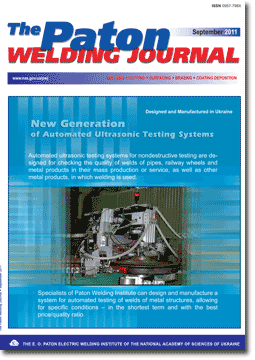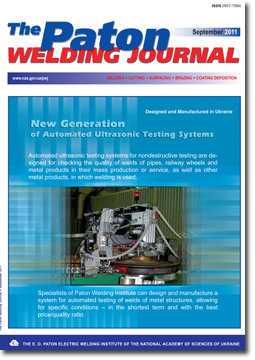| 2011 №09 (02) | 2011 №09 (04) |

The Paton Welding Journal, 2011, #9, 16-21 pages
EXPERIMENTAL INVESTIGATION OF HOT CRACKING SUSCEPTIBILITY OF WROUGHT ALUMINUM ALLOYS
P. KAH, E. HILTUNEN and J. MARTIKAINEN
Lappeenranta University of Technology, Lappeenranta, Finland
Abstract
The process of gas tungsten arc (GTA) and gas metal arc (GMA) welding of heat treatable wrought aluminum alloys 6005-T6 and 6082-T6, filler metal composition and preheating temperature as the main factors affecting the formation of hot cracking are considered. It has been shown in experiments that specimens welded with 5356 filler wire are more prone to hot cracking than those welded with 4043 wire, and GMAW demonstrates less cracks than GTAW due to its lower heat input. The effect of preheating proves to have little or no consequence.
Keywords: hot cracking, GMAW, GTAW, filler alloys, preheating, alloy 6005, alloy 6082, heat input
Received: ??.??.??
Published: 28.09.11
References
1. Adamowski, J., Szkodo, M. (2007) Friction stir welds of aluminum alloy AW6082-T6. J. Achievements in Materials and Manufact. Eng., 20, 403-406.
2. Cross, C.E., Bollinghaus, T. (2006) The effect of restraint on weld solidification cracking in aluminum. Welding in the World, 50, 51-54.
3. Mazzolani, F.M. (1995) Aluminium alloy structures. 2nd ed. London: Chapman & Hall.
4. Gittos, N.F., Scott, M.H. (1981) Heat affected zone cracking of Al-Mg-Si alloys. Welding J., 60(6), 95-103.
5. Kou, S. (2003) Solidification and liquation cracking issues in welding. Welding J. Minerals, Metals and Materials, 55(6), 37-41.
6. Huang, C., Kou, S. (2000) Partially melted zone in aluminium welds Д liquation mechanism and directional solidification. Supl. to Welding J., May, 113-120.
7. Huang, C., Kou, S. (2002) Liquation mechanisms in multicomponent aluminum alloys during welding. Welding J., Oct., 211-222.
8. Huang, C., Kou, S. (2003) Liquation cracking in partial-penetration Al-Mg-Si welds. Ibid., July, 184-193.
9. Huang, C., Kou, S. (2004) Liquation cracking in full penetration Al-Mg-Si welds. Ibid., April, 111-121.
10. Cao, G., Kou, S. (2006) Predicting and reducing liquationcracking susceptibility based on temperature vs fraction solid. Ibid., Jan., 9-18.
11. Hunziker, O., Dye, D., Reed, R.C. (2000) On formation of a centerline grain boundary during fusion welding. Acta Mater., 48(17), 4191-4201.
12. Messler, R.W. Jr. (2004) Principle of welding. Weinheim: Wiley.
13. Davis, J.R. Jr. (1994) Aluminum and aluminum alloys: ASM specialty handbook.
14. Kou, S. (2003) Welding metallurgy. 2nd ed. New York: John Wiley.
15. Ma, T., Den Ouden, G. (1999) Int. J. Joining of Materials Denmark, 11(3), 61-67.
16. Yeomans, S.R. (1990) Successful welding of aluminium and its alloys. Australian Welding J., 4th quart.
17. Grong, O. (1994) Metallurgical modeling of welding. 2nd ed.
18. (1994) Lincoln Electric procedure handbook of arc welding. Cleveland: Lincoln Electric.
19. Rao, K.P., Ramanaiah, N., Viswanathan, N. (2008) Partially melted zone cracking in AA6061 welds. Materials and Design, 29, 179-186.
20. Schenk, T., Richardson, I.M., Kraska, M. et al. (2009) A study on the influence of clamping on welding distortion. Comput. Materials Sci., 45, 999-1005.
21. Akahter, R., Ivanchev, L., Burger, H.P. (2007) Effect of pre/post T6 heat treatment on the mechanical properties of laser welded SSM cast A356 aluminum alloy. Materials Sci. and Eng. A, 447, 192-196.
22. Funderburk, S. (1998) What is preheat? Cleveland: Lincoln Electric.
23. Lyndon, B.J. (2006) Process specification for the heat treatment of aluminum alloys space center. Houston, Texas: NASA.
Suggested Citation
P. KAH, E. HILTUNEN and J. MARTIKAINEN (2011) EXPERIMENTAL INVESTIGATION OF HOT CRACKING SUSCEPTIBILITY OF WROUGHT ALUMINUM ALLOYS. The Paton Welding J., 09, 16-21.The cost of subscription/purchase order journals or individual articles
| Journal/Currency | Annual Set | 1 issue printed |
1 issue |
one article |
| TPWJ/USD | 384 $ | 32 $ | 26 $ | 13 $ |
| TPWJ/EUR | 348 € | 29 € | 24 € | 12 € |
| TPWJ/UAH | 7200 UAH | 600 UAH | 600 UAH | 280 UAH |
| AS/UAH | 1800 UAH | 300 UAH | 300 UAH | 150 UAH |
| AS/USD | 192 $ | 32 $ | 26 $ | 13 $ |
| AS/EUR | 180 € | 30 € | 25 € | 12 € |
| SEM/UAH | 1200 UAH | 300 UAH | 300 UAH | 150 UAH |
| SEM/USD | 128 $ | 32 $ | 26 $ | 13 $ |
| SEM/EUR | 120 € | 30 € | 25 € | 12 € |
| TDNK/UAH | 1200 UAH | 300 UAH | 300 UAH | 150 UAH |
| TDNK/USD | 128 $ | 32 $ | 26 $ | 13 $ |
| TDNK/EUR | 120 € | 30 € | 25 € | 15 € |
AS = «Automatic Welding» - 6 issues per year;
TPWJ = «PATON WELDING JOURNAL» - 12 issues per year;
SEM = «Electrometallurgy Today» - 4 issues per year;
TDNK = «Technical Diagnostics and Non-Destructive Testing» - 4 issues per year.


